
Allow me to tell the story of two separate encounters with a magical place on a remote Japanese island.
Reaching it takes a full day of travel. Getting there, in a nutshell — take the bullet train from Tokyo across Japan's main island, continuing through Kyushu to the final stop at its southernmost point. There, at Kagoshima, board the hydrofoil ferry that heads out to the open sea — first navigating the smooth waters of Kagoshima Bay, then rounding the tip of Satsuma Peninsula, then through the choppy waters of the East China Sea, until finally, at 30°N/130°E, you arrive at the island of Yakushima 屋久島.
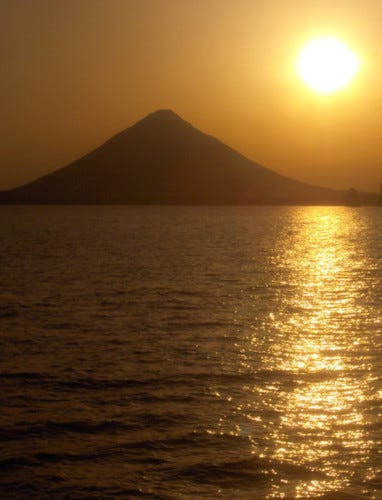
Yakushima is the last island of any real size in the area. It measures about 30 kilometers across, so it's a bit smaller than Kauai, Hawai'i. The interior of its circular shape is mountainous, with Mount Miyanoura, and its handsome granite outcroppings, towering nearly two thousand meters above the ocean's surface. Only a thin ribbon of flat land exists around Yakushima's perimeter, where the island's 12,000 inhabitants reside.
The climate of Yakushima is what makes it unique. Summers are warm and rainy; winters are mild and rainy. It rains almost every day — the port village of Anbō gets 4.5 meters of rainfall per year! This over-abundance of water is what makes everything so spectacular.
When it's not raining, the sun strikes the saturated soil and the rain-soaked leaves causing a fine mist to rise and hover over the landscape. When disembarking from the ferry, that wispy atmosphere welcomes visitors with its dreamy feeling.
I was first drawn to this place by the description of its lush forests, densely packed with layers of trees. In particular, the ancient cedars are what I came to see. They live for centuries, expanding their girth decade by decade until they resemble overweight hermits. The oldest, Jomon Sugi, is 16 meters in circumference! Many of these trees are considered deities and have sacred bamboo shimenawa 標縄 ropes tied with white shide 紙垂 streamers wrapped around their bellies. Their very age demands respect, with some of them having lived through all of recorded history and before.
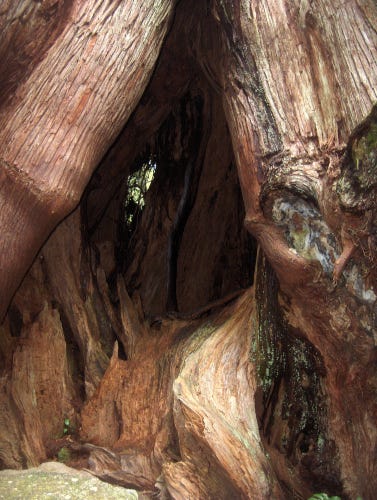
As long ago as 1635 CE [寛永 Kan'ei 11] the cedars were harvested, split into thin shakes, carried out of the mountains on the backs of men, and transported to the mainland for use in the building industry. The natural insect repellence of the aromatic wood makes them an excellent roofing material. The trails used by those haulers, all those years ago, are still there, and used today by backpackers and day-trippers.
The interpretive signs along the way tell the story of the island's long-held conservation ethic. At some point in the 18th century laws were passed to regulate logging in order to keep the industry viable for future generations. Today, the second growth trees planted by those early foresters are healthy and growing, and patches of virgin forest still remain intact.
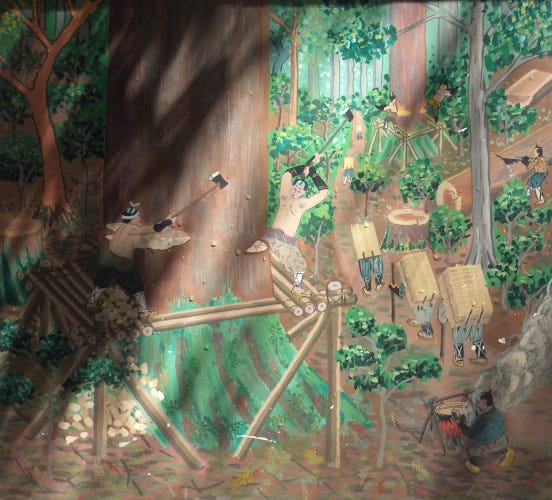
That conservation ethic has imbued all aspects of the island's culture. More than a third of the island is now Yakushima National Park. The values of self-sufficiency, sustainability, and stewardship have been internationally recognized. UNESCO has designated the island's virgin forest area as a World Natural Heritage Site. This year, the island will commemorate the 30th anniversary of that registration on November 25th with a symposium where participants will work on further initiatives that promote sustainability.
Walking up and down the steep terrain along those ancient trails is like praying. Raindrops filter through the overstory and drip from every shrub and fern — showering any pilgrims below with blessings — before settling inaudibly into a lush carpet of moss that blankets everything.
The canopy of the overstory blocks most of the sunlight, leaving much of the understory open. Here and there, vines climb the branchless trunks in their struggle to reach the light, while short, shade-tolerant rhododendrons and camellias group themselves into little communities as they compete for soil and sunshine.
The effect is like a cathedral, and the urge to look up from the nave to the lofty ceiling is irresistible. When alone, I felt like Adam, marveling at all of God's creation, curious to see what wonders I would discover around the next turn. It was a primeval experience.
At one point, as I rounded a bend in the trail, I was rudely shaken from my reverie by bright red litter scattered across the trail ahead. "Now what kind of thoughtless individual would have done such a sacrilegious thing?" I thought to myself. As the scatterings come into focus I recognized them as camellia petals, and upon further investigation realized that their sweet inner cores were not present. Putting two and two together I concluded that the monkeys — having a mid-day snack — were the culprits.
The Yakushima macaque (an Old World monkey) is endemic to the island. At one point, biologists determined that their population had declined enough for them to be placed on the Ministry of the Environment's Red List of endangered species. In recent years they have rebounded, and now number between ten and twenty thousand. They are common enough to be a bit of a nuisance at times. Nevertheless, with classic Japanese stoicism, our bus driver on the way up the mountain expertly piloted us through troops of macaques picnicking on guardrails, corralling their young ones, or just grooming themselves while lounging on the roadside pavement.
And then there are the Yakushima deer, a subspecies of the ones that reside in Nara. They are smaller, and less gregarious than their mainland cousins. With dwarf-sized legs and short necks, even the adults are as cute as Bambi. By happenstance, their population is close in numbers to the macaques. So curiously, the island's three largest mammals (macaques, deer, and humans) each have roughly the same population. To me, that balance lends even more credence to the idea that Yakushima's conservation ethic is authentic and sustainable.
All of these forestry wonders are beautifully captured in Hayao Miyazaki's blockbuster anime film "Princess Mononoke". Fans of Studio Ghibli can snap a selfie at one spot in particular along the Shiratani Unsuikyo forest trail, said to be the real life model for one of the film's scenes. Truth be told, it would be hard for me to separate that spot from all the others — every direction, kilometer after kilometer, is dripping in lush greenery.
While the ancient cedars rightfully get top billing, the Stewartia are a close 2nd for me. These trees have striking orange-brown trunks mottled like an impressionist painting, as flakes of yellow and green are revealed wherever the cambium has peeled away. The effect is muscular. One can't help but think of them as body-builders showing off in front of their fancy green lovers.
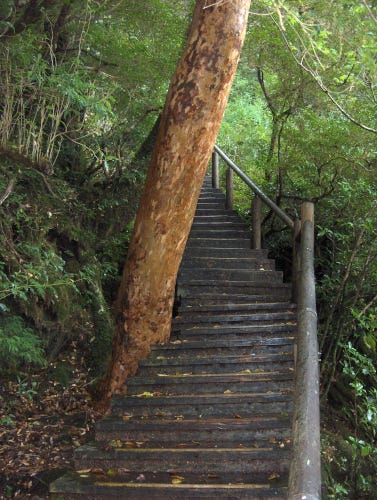
Yakushima owes its profusion of life to its geographic placement. Being at 30°N latitude means it shares the same solar cycle as Cairo, but what prevents Yakushima from becoming like the Sahara is the Kuroshio Current. That oceanic river sends warm equatorial water through the Tokara Strait, rubbing up against Yakushima's coastline. When the current's moisture-laden air is forced up and over Mount Miyanoura, the change in pressure triggers the spontaneous formation of precipitation. Anyone who's been to Hawai'i will recognize what's going on.
The Kuroshio Current is also what guides the loggerhead turtles back to Yakushima in large numbers every summer, to use the beaches on the island as nesting sites. Ninety-five percent of the world's entire population are hatched on the beaches of Yakushima and nearby islands.
Once hatched the newborn turtles crawl to the open Pacific, where they can live for 60 or more years. Adult loggerheads can grow to be 450kg in weight and nearly a meter in diameter. They roam across the far reaches of the ocean, and have been tracked along their migratory path from the west coast of Mexico, more than 14,000 kilometers away. Islanders are aware of these impressive feats, and take special care to protect the turtles and their habitat.
My first enchanted visit to Yakushima was in 2007. I returned for a second visit in 2019, hoping to relive that dreamy experience. The second time around, it was still wonderful, but there was a certain sadness that cast a shadow over the place and its future.
In the intervening decade the world's appetite for plastics has run amok. The Great Pacific Garbage Patch has become a reality. And the Kuroshio Current has carried myriad bits of floating plastic to the shores of Yakushima. Every day the tides dump jetsam, from all parts of the Pacific Rim, onto the very beaches that loggerheads have been using since time immemorial to nest and hatch their next generation. Today, our careless disposal of plastics into the oceans is threatening to destroy that unbroken line of ancestry.
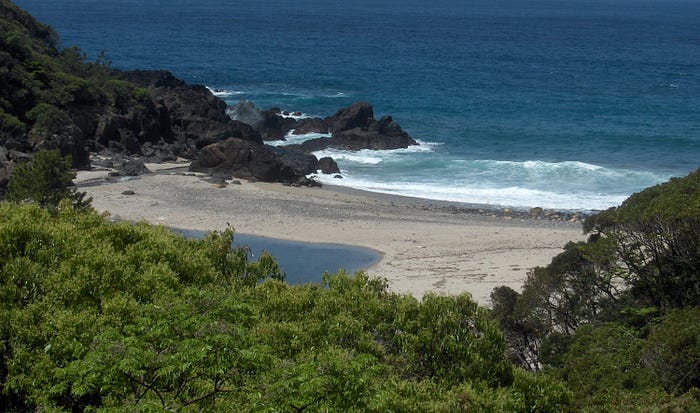
Buoys, longlines, gillnets, traps, pots, oars, hulls, buckets, containers, bottles, balloons, and so much more, are ignominiously deposited as each tide recedes. First the large stuff, way up near the tree line, then the smaller items on the beach itself, and finally the broken pieces, as small as Coquina shells, speckling every part of the once white sand, resembling the discarded pieces of a jigsaw puzzle that has no hope of ever being put together.
Paradise lost in just a dozen years. Sigh.
I am no longer worried that my favorite place will be overrun by tourists. No, the people of Yakushima have a strong enough conservation ethic to ensure that any number of visitors won't wreck its special qualities. Instead, I'm now making a point of encouraging everyone to visit Yakushima, to see firsthand the wonders of nature, and to take home the urgent message that we must do better.

